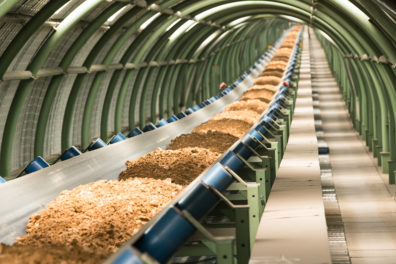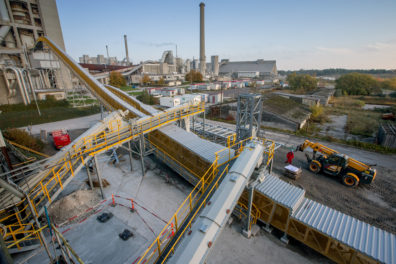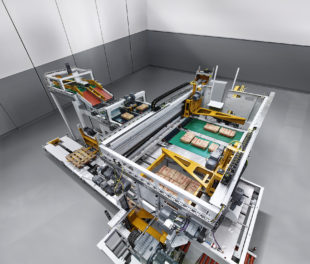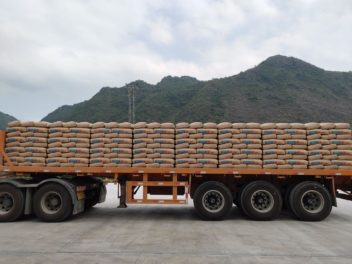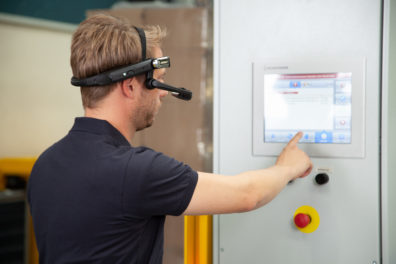BEUMER Group: Trends in the cement industry
BEUMER sales manager Kay Wieczorek is sure: “In the coming years, there will be a lot of changes in the cement industry. COVID-19 makes personal interaction with customers nearly impossible during the current times and advises owners to be careful when making investments. Nevertheless, the crisis offers many opportunities for system providers: the digitalisation, the use of alternative fuels or the need for automation. The change from 50-kg to 25-kg bags in some countries world-wide will also be a big challenge for the market.
“Over the past months, COVID-19 has forced us to cope with some changes. This will probably bother us even more in the colder months,” Kay Wieczorek is convinced. He is head of sales for the cement industry at BEUMER Group, a company which since its foundation in 1935 develops future-oriented solutions for the construction and cement industry. “Even if the COVID-19 figures are currently in progress, I am sure that BEUMER Group will come through this crisis pretty well; we just have to be well prepared for it.” This means: recognising trends and offering the right solutions.
Digitalisation instead of trips
Contacting with their customers world-wide is what Kay Wieczorek and his colleagues in the sales department are missing the most over the past several months. This is very important in a sector where business deals are concluded not only with a signature, but mostly with a firm handshake. “The pandemic is massively changing our travel behaviour and the way we hold meetings and sign contracts,” he says. Communication is becoming more and more digital. “The increasing digitalisation will make its way into the rather conservative cement industry,” Wieczorek is convinced. Even if many cement plant owners are still reacting rather hesitantly to this development, they do see the advantages. “We may not be on site at the customers’ premises right now, but we can still support them, for example with our BEUMER Smart Glasses,” says the cement expert. What happens if for example a packaging system in Indonesia or Peru fails? BEUMER Group is globally well positioned with its numerous subsidiaries and representatives and can, if necessary, dispatch one of the world-wide stationed technicians where needed, but even this takes time – provided that the Corona measures allow it at all. Alternatively, the system provider is available around the clock via the hotline. But what about complex problems which cannot be clearly communicated over the phone? “Customers can work with a service technician while wearing our BEUMER Smart Glasses to have all important information displayed in the live image of the camera”, describes Kay Wieczorek. “This enables the customer to repair the machine himself – just as if one of our technicians were at his side.” The data glasses serve also for remote commissioning and allow both parties to look over the whole system: Wearing the data glasses, BEUMER Customer Support can see the same images as the technician on site and can directly specify the correct actions to take. This way, the user is guided step by step through the commissioning process. Remote maintenance is also possible and enables BEUMER experts to connect to the system regardless of time or day. This increases the machine availability, as it is not necessary to travel long distances. “This is a good alternative for our sector,” Wieczorek is convinced. However, personal contact is still imperative.
The increasing digitalisation implies the increasing use of sensors to collect and evaluate information at critical points. This may concern the use of contactless proximity switches that reliably transmit signals without mechanical contacts. The use of high-quality photocells ensures signal transmission even under difficult environmental conditions and the sensors used increase the machine capacity. Thus, the user can both considerably reduce the maintenance costs and make the spare parts handling more transparent.
Alternative fuels – economic and ecological
“Alternative fuels are another great trend in the cement industry,” recognises Kay Wieczorek. “World-wide, this is also promoted by politicians in various countries in order to get air pollution under control”. When producing cement, large quantities of carbon dioxide is emitted. Depending on the processes used, the emissions from producing cement are at 0.6 to 0.99 t of CO2 per ton of cement. The CO2 emissions from this sector are estimated to account for seven to eight percent of the overall global carbon dioxide emissions. An approach to sustainably reduce greenhouse gas emissions and production costs is to increase the use of alternative fuels. Fluid materials like waste oil or solvents for example are used instead of coal and gas. The majority of the solid alternative fuels are composed of municipal and industrial waste, such as plastic, paper, composite material or textile mixes. “However, we cannot throw the complete household waste into the kiln,” Wieczorek says. “Because different materials also have different calorific values.” Especially in countries where waste separation is not developed like in Europe, the challenge is huge. On the contrary, the use of shredded waste tyres is welcome. The calorific value of the rubber from waste tyres is comparable to that from hard coal, and the iron from the reinforcement can be incorporated mineralogically into the cement. This minimises the addition of ferrous corrective substances.
As a system provider, BEUMER Group develops tailor-made solutions for the entire material flow chain from unloading the delivery vehicle to storing, weighing, conveying and control feeding of solid alternative fuels. BEUMER Group also provides fully automated systems that can control feed, singulate and convey large and heavy tyres to the inlet of the rotary kiln. “Our intralogistics solutions permit us to support the cement companies in modernising their plants in sustainable and cost-efficient ways,” Wieczorek explains.
However, CO2 can be further reduced – and not only by energy-efficient systems and the use of alternative fuels and raw materials (AFR). An important aspect is the transport of raw materials from the quarry to the plant or the port. The routes often lead through rough terrain or even populated areas. This is a task companies often handle by trucks, which emit large quantities of carbon dioxide. “At this regard we offer troughed belt conveyors and closed Pipe Conveyors. The conveyors are more environmentally friendly and can be considerably more economical – they can. Deciding if the investment is worthwhile depends on several factors,” Wieczorek explains. The BEUMER specialists help with feasibility studies and cost comparison to take the right decision.
Diet with consequences
“What has been partly implemented in Europe since decades, will also be implemented in some other countries around the world in the coming years – the change from 50-kg bags to 25-kg bags,” says Wieczorek. This was triggered by new legal requirements for the health protection of workers, who have to lift and tow these bags. “For us, this means that we have to gradually retrofit the systems in the packaging lines at our customers’ site,” the BEUMER expert describes. “This will be an enormous challenge, because the packaging lines in the plants must of course fill and pack the same amount of cement as before – and thus handle twice the number of bags in the same time”.
But even if the weight of the bags has been reduced to half of it – the manual loading on the truck bed is still hard work. “And fewer and fewer people in India, China and Africa are willing to do so,” says Wieczorek. Also in the emerging countries, it is becoming more and more difficult to find appropriate personnel for this kind of work. In addition, labour costs are climbing in these countries. Manual truck loading is exhausting and usually requires two people who alternate with their colleagues for each loading process due to the heavy physical work involved. Furthermore, there is the high level of dust formation, which affects the employees’ health. During the manual loading process, the loading performance as well as the quality of the bag stacks often fluctuates. “These problems are omitted if the BEUMER autopac is used”, says the BEUMER expert. “One employee is able to operate more than one machine.” This enables owners to optimise processes, achieve high loading capacities and work very efficiently from bagging up to loading. Thus, automation is a world-wide trend.
“We have further developed this machine,” says Wieczorek. “We offer a version, which can be adapted to very different truck bed widths”. The BEUMER autopac offers a further advantage – no pallets are required. In many countries there is simply a lack of wood, and the logistics to store the empty pallets. This exceeds the possibilities and capacities of many companies. “Imagine a plant which stacks 5,000 to 6,000 bags per hour on pallets. The storage of these pallets may require a surface of several hundred square metres,” says Wieczorek.
Investing despite of uncertainty
“In 2020, the pandemic caused a huge slump in the market,” reports BEUMER sales manager Wieczorek. “The owners are unsettled because they cannot estimate how the coming years will develop. However, the reason is not only COVID-19”, he says. “The number of new built cement lines is considerably fewer than years ago. In 2010 approx. 200 cement lines were set up in China, in 2019 exactly 18. Of course, this is partly due to the enormous overcapacity, especially in China. For a long time, the Chinese government has pushed forward large building projects and as a consequence the production of huge quantities of cement – which were partly exported en masse. These times are over now. In the cement plants, the owners are for example having three lines retrofitted to a large one,” noticed Wieczorek. But also this requires know-how and technique. World-wide “Made in Europe” is still considered a quality seal, especially with regard to process-critical equipment, Wieczorek knows the market. The need for cement is still high, even if this is not reflected in the sale of new systems. Many owners wait before making major investments and consider whether the investment is really worthwhile. But even if the industry is currently reserved, the number of concrete projects and inquiries is raising again,” Wieczorek says satisfied. “This movement gives us hope. I am sure that the willingness to invest will raise again in the near future”.
